-

新人教版高中英语选修2Unit 3 Using langauge-Listening教学设计
1. How is Hunan cuisine somewhat different from Sichuan cuisine?The heat in Sichuan cuisine comes from chilies and Sichuan peppercorns. Human cuisine is often hotter and the heat comes from just chilies.2.What are the reasons why Hunan people like spicy food?Because they are a bold people. But many Chinese people think that hot food helps them overcome the effects of rainy or wet weather.3.Why do so many people love steamed fish head covered with chilies?People love it because the meat is quite tender and there are very few small bones.4.Why does Tingting recommend bridge tofu instead of dry pot duck with golden buns?Because bridge tofu has a lighter taste.5 .Why is red braised pork the most famous dish?Because Chairman Mao was from Hunan, and this was his favorite food.Step 5: Instruct students to make a short presentation to the class about your choice. Use the example and useful phrases below to help them.? In groups of three, discuss what types of restaurant you would like to take a foreign visitor to, and why. Then take turns role-playing taking your foreign guest to the restaurant you have chosen. One of you should act as the foreign guest, one as the Chinese host, and one as the waiter or waitress. You may start like this:? EXAMPLE? A: I really love spicy food, so what dish would you recommend?? B: I suggest Mapo tofu.? A: Really ? what's that?

新人教版高中英语选修2Unit 4 Learning about Language教学设计
This section guides students to pay attention to the typical context of vocabulary use, helps students accumulate vocabulary around the key vocabulary of this unit, and uses the learned words and word chunks in different contexts to deeply understand their meaning and usage, so as to achieve the purpose of review and consolidation.The teaching design activities aim to guide students to pay attention to the typical context in which the target vocabulary is used, as well as the common vocabulary used in collocation, so that students can complete the sentence with correct words. In terms of vocabulary learning strategies, this unit focuses on cultivating students' ability to pay attention to collocation of words and to use word blocks to express meaning.For vocabulary learning, it is not enough just to know the meaning of a single word, but the most important thing is to master the common collocations of words, namely word blocks.Teachers should timely guide students to summarize common vocabulary collocation, such as verb and noun collocation, verb and preposition collocation, preposition and noun collocation, and so on.1. Guide students to understand and consolidate the meaning and usage of the vocabulary in the context, 2. Guide the students to use the unit topic vocabulary in a richer context3. Let the students sort out and accumulate the accumulated vocabulary, establishes the semantic connection between the vocabulary,4. Enable students to understand and master the vocabulary more effectivelyGuiding the Ss to use unit topic words and the sentence patterns in a richer context.

新人教版高中英语选修2Unit 4 Using langauge-Listening教学设计
The theme of the listening section is " talking about scenery and culture along a journey."The part is designed to further lead the students to understand Canadian natural geography and social environment, and integrated into the cultural contrast by mentioning the long train journey from Beijing to Moscow routes. On this basis, the part activates students related travel experience, lets the student serial dialogue, guides the student to explore further the pleasure and meaning of the long journey, and Chinese and foreign cultural comparison.The part also provides a framework for the continuation of the dialogue, which is designed to provide a framework for students to successfully complete their oral expressions, and to incorporate an important trading strategy to end the dialogue naturally.1. Help students to understand and master some common English idioms in the context, and experience the expression effect of English idioms.2. Guide the students to understand the identity of different people in the listening context, and finish the dialogue according to their own experience.3. Instruct the students to use appropriate language to express surprise and curiosity about space and place in the dialogue, and master the oral strategy of ending the dialogue naturally.1. Instruct students to grasp the key information and important details of the dialogue.2. Instruct students to conduct a similar talk on the relevant topic.

新人教版高中英语选修2Unit 5 Learning about Language教学设计
The purpose of this section of vocabulary exercises is to consolidate the key words in the first part of the reading text, let the students write the words according to the English definition, and focus on the detection of the meaning and spelling of the new words. The teaching design includes use English definition to explain words, which is conducive to improving students' interest in vocabulary learning, cultivating their sense of English language and thinking in English, and making students willing to use this method to better grasp the meaning of words, expand their vocabulary, and improve their ability of vocabulary application. Besides, the design offers more context including sentences and short passage for students to practice words flexibly.1. Guide students to understand and consolidate the meaning and usage of the vocabulary in the context, 2. Guide the students to use the unit topic vocabulary in a richer context3. Let the students sort out and accumulate the accumulated vocabulary, establishes the semantic connection between the vocabulary,4. Enable students to understand and master the vocabulary more effectivelyGuiding the Ss to use unit topic words and the sentence patterns in a richer context.Step1: Read the passage about chemical burns and fill in the blanks with the correct forms of the words in the box.

新人教版高中英语选修2Unit 5 Reading and thinking教学设计
The theme of this activity is to learn the first aid knowledge of burns. Burns is common in life, but there are some misunderstandings in manual treatment. This activity provides students with correct first aid methods, so as not to take them for granted in an emergency. This section guides students to analyze the causes of scald and help students avoid such things. From the perspective of text structure and collaborative features, the text is expository. Expository, with explanation as the main way of expression, transmits knowledge and information to readers by analyzing concepts and elaborating examples. This text arranges the information in logical order, clearly presents three parts of the content through the subtitle, accurately describes the causes, types, characteristics and first aid measures of burns, and some paragraphs use topic sentences to summarize the main idea, and the level is very clear.1. Guide students to understand the causes, types, characteristics and first aid methods of burns, through reading2. Enhance students’ ability to deal withburnss and their awareness of burns prevention3. Enable students to improve the ability to judge the types of texts accurately and to master the characteristics and writing techniques of expository texts.Guide students to understand the causes, types, characteristics and first aid methods of burns, through readingStep1: Lead in by discussing the related topic:1. What first-aid techniques do you know of ?CPR; mouth to mouth artificial respiration; the Heimlich Manoeuvre

新人教版高中英语选修2Unit 5 Using langauge-Listening教学设计
The theme of this section is to learn how to make emergency calls. Students should learn how to make emergency calls not only in China, but also in foreign countries in English, so that they can be prepared for future situations outside the home.The emergency telephone number is a vital hotline, which should be the most clear, rapid and effective communication with the acute operator.This section helps students to understand the emergency calls in some countries and the precautions for making emergency calls. Through the study of this section, students can accumulate common expressions and sentence patterns in this context. 1.Help students accumulate emergency telephone numbers in different countries and learn more about first aid2.Guide the students to understand the contents and instructions of the telephone, grasp the characteristics of the emergency telephone and the requirements of the emergency telephone.3.Guide students to understand the first aid instructions of the operators.4.Enable Ss to make simulated emergency calls with their partners in the language they have learned1. Instruct students to grasp the key information and important details of the dialogue.2. Instruct students to conduct a similar talk on the relevant topic.Step1:Look and discuss:Match the pictures below to the medical emergencies, and then discuss the questions in groups.

新人教版高中英语选修2Unit 4 Reading for writing教学设计
假定你是英国的Jack,打算来中国旅行,请你给你的中国笔友李华写一封信,要点如下:1.你的旅行计划:北京→泰山→杭州;2.征求建议并询问他是否愿意充当你的导游。注意:1.词数80左右(开头和结尾已给出,不计入总词数);2.可以适当增加细节,以使行文连贯。参考词汇:故宫 the Forbidden City;泰山 Mount TaiDear Li Hua,I'm glad to tell you that 'm going to visit China.First,I am planning to visit Beijing,the capitalof China,where I am looking forward to enjoying the Great Wall,the Forbidden City and somebeautiful parks.Then I intend to go to visit Mount Tai in Shandong Province.I've heard that it is one ofthe most famous mountains in China and I can't wait to enjoy the amazing sunrise there.After that,I amalso going to Hangzhou.It is said that it is a beautiful modern city with breathtaking natural sights,among which the West Lake is a well- known tourist attraction.What do you think of my travel plan? Will you act as my guide? Hope to hear from you soon.

部编版语文九年级下册《变色龙》教案
小结:总之,手指头的细节描写写出了赫留金的命运和遭遇,它从反面衬托出奥楚蔑洛夫见风使舵、媚上欺下的卑劣品质,反映了沙皇统治下社会的黑暗。目标导学五:分析讽刺艺术,把握文章主旨1.作为一篇讽刺小说,本文主要运用了哪些手法表现讽刺艺术?明确:夸张。讽刺小说往往离不开夸张,本文也是如此。在短短的时间里,随着狗的主人的身份不断变化,奥楚蔑洛夫的态度也发生了多次变化。变化之快,跨度之大,令人瞠目。夸张手法的巧妙运用,使人物性格鲜明突出,给人留下了深刻的印象。对比。奥楚蔑洛夫面对狗主人身份的变化,不停地改变着自己的态度,时而威风凛凛,时而奴颜婢膝,一会儿痛骂小狗是“疯狗”“下贱胚子”,一会儿又夸小狗“名贵”“伶俐”,前后矛盾,对比鲜明,自己打自己的嘴巴,使小说的喜剧效果更加突出。
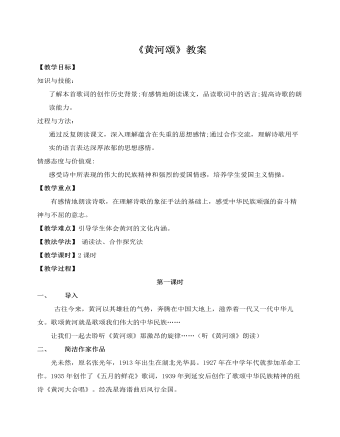
部编版语文七年级下册《黄河颂》教案
六、讨论、探究:1、“黄河的精神”是什么?从本文的哪些词句中可以体会黄河的这种精神?中华民族伟大坚强的精神 2、作者借歌颂黄河表达了怎样的思想感情?作者借歌颂黄河来歌颂中华民族的灿烂文化,歌颂中华民族的伟大精神,歌颂中华儿女的勤劳勇敢、伟大坚强,从而激发整个民族以英勇的气概和坚强的决心来保卫黄河,保卫中国。 3、如何理解黄河是“摇篮”,是“屏障”?把黄河比喻为“中华民族的摇篮”是因为黄河是中华民族的发祥地,黄河哺育、滋养了世代炎黄子孙。把黄河比喻为“民族的屏障”,侧重于黄河对中华民族的保卫作用而言。黄河天险在地理上可作为军事屏障,黄河伟大坚强的精神,更足以成为民族精神上的城防。重点揭谜这是一个比喻句,把黄河比喻为一个巨人,黄河主流是巨人的躯干,黄河流域中的无数条支流就是“巨人”身上千万条“铁的臂膀”。它体现了气势磅礴、勇不可挡的气度和力量,正足以激发民族的精神和信念。
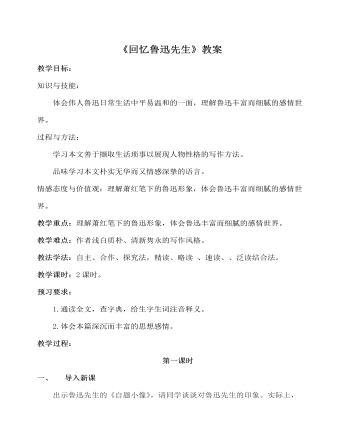
部编版语文七年级下册《回忆鲁迅先生》教案
2.创作背景鲁迅说过:“想看好花。一定要有好土。”又曾表示:“只要能培一朵花,就不妨做会朽的腐草。”为了培育萧红这朵中国三四十年代中国女性文学园圃的奇葩,鲁迅甘作春泥,甘为人梯,在她的作品中倾注了大量心血;鲁迅去世之后,萧红从悲痛中振作起来,陆续出版和发表了《马伯乐》《回忆鲁迅先生》《呼兰河传》等名篇佳作。这些作品又像春泥一样,继续滋养着中国文坛的茂林佳卉。鲁迅和萧红之间的情谊已经成为文坛佳话,被千千万万的读者传诵……在林林总总的鲁迅回忆录中。萧红的《回忆鲁迅先生》一枝独秀。它不仅是鲁迅回忆录中的珍品。而且是中国现代怀人散文的典范,是敬献于鲁迅墓前的一个永不凋谢的花环。由于作者萧红跟回忆对象鲁迅之间有着直接交往,对回忆对象充满着缅怀崇敬之情,素材又来自于亲历、亲闻,因此作品不仅富于史传性,而且也富于文学性。
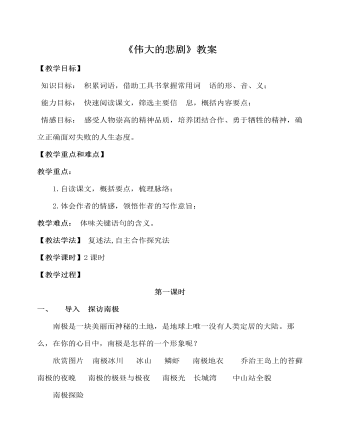
部编版语文七年级下册《伟大的悲剧》教案
千百年来,南极这个亘古长眠的世界一面向世人展示着自己冰肌玉骨、绝世无双的美丽,一面以其层层冰嶂、酷冷奇寒的肃杀之气凛然回绝了人类无数次好奇的拜访。因为那里的天气实在是太恶劣了。而近百年来,无数探索者在南极留下了他们的足迹,他们为人类的进步事业作出了自己的贡献,有的甚至献出了宝贵的生命。1911年,两位著名的探险家挪威人阿蒙森和英国人斯科特踏上了冲击南极点的征程。这两个人都想成为第一个到达南极点的英雄。经过一番激烈的竞争,结果是阿蒙森队捷足先登,于1911年12月14日到达南极,而斯科特队则于1912年1月18日才到达,比阿蒙森队晚了将近五个星期。最后,阿蒙森胜利而归,成功的旗帜永远飘扬在南极点上,而斯科特等五名冲击南极的英雄,因为南极寒冷天气的突然提前到来,饥寒交迫,体力不支,在返回的途中与严寒搏斗了两个多月,最后长眠在茫茫的冰雪之中。
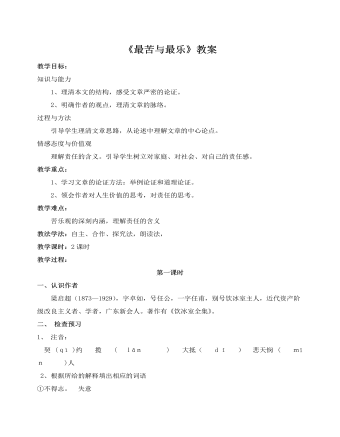
部编版语文七年级下册《最苦与最乐》教案
② 什么事最快乐呢?(用原文语句回答)责任完了,算是人生第一件乐事。③用文中语句概括第4自然段的内容。天下事从苦中得来的乐才算真乐。④请从最后一段中找出与“快乐之权,操之在己”内涵相符的一句:尽得大的责任,就得大快乐;尽得小的责任,就得小快乐。第二课时四、师生探究讨论第一部分:1、文章开头设问“人生什么事最苦?”提到了哪些事,它们是最苦的事吗?贫→知足;失意→安分;老、死→达观。作者认为它们可以从心态上、观念上去排解。2、接着作者提出自己的见解,人生什么事最苦呢? (请用原文回答)我说人生最苦的事,莫若身上背着一种未了的责任。3、作者举了哪些例子证明自己的观点?从个人对他人的责任(承诺未完、欠人钱、受人恩惠、得罪人等)再延伸到对家庭、社会、国家,乃至于对自己都有责任,一旦应尽的责任没有尽,这种痛苦无法解脱。

部编版语文九年级下册《词四首》教案
二、教学新课目标导学一:《破阵子·为陈同甫赋壮词以寄之》1.认识作者,了解写作背景。辛弃疾(1140—1207),字幼安,号稼轩,南宋词人,著有《稼轩词》,存词600多首,其词抒写力图恢复国家统一的爱国热情,倾诉壮志难酬的悲愤,对当时执政者的屈辱求和颇多谴责;也有不少吟咏祖国河山的作品。题材广阔又善化用前人典故入词,风格沉雄豪迈又不乏细腻柔媚。辛弃疾年轻时参加抗金起义,失败后南归,极力主张收复中原,却遭到排斥打击,长期不得任用,闲居近二十年,这首词是作者失意闲居信州(今江西上饶)时所作。陈同甫(1143—1194),名亮,与辛弃疾都力主抗金,志同道合,结为挚友。其词风格与辛词相似。2.研读细品,理解本词的情感与主旨。(1)“醉里挑灯看剑,梦回吹角连营。”作者为什么要“醉”?词人挑灯看剑,在梦中回到连营体现了什么?
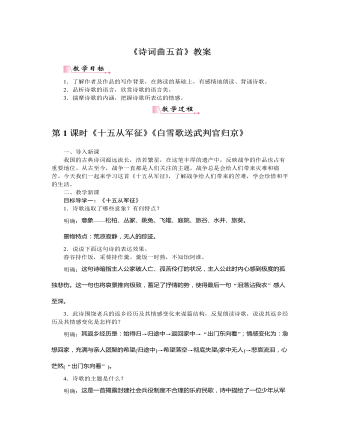
部编版语文九年级下册《诗词曲五首》教案
(5)这首诗表达了什么感情?请简要分析。明确:这首诗饱含沉痛悲凉,既叹国运又叹自身,把家国之恨、艰危困厄渲染到极致。最后一句由悲而壮、由郁而扬,慷慨激昂、掷地有声,以磅礴的气势、高亢的语调显示了诗人的民族气节和舍生取义的生死观。目标导学三:《山坡羊·潼关怀古》1.了解作者和创作背景及诗歌体裁张养浩(1270—1329),字希孟,号云庄,山东济南人,元代文学家。他诗、文兼擅,而以散曲著称。张养浩为官清廉,爱民如子。天历二年(1329年),因关中旱灾,被任命为陕西行台中丞以赈灾民。《山坡羊·潼关怀古》便写于应召往关中的途中。散曲:到了元代,出现新兴的体裁——曲。曲大致分为两种,一是剧曲,一是散曲。散曲没有动作、说白,包括套数和小令两种基本形式。套数由若干曲子组成,小令以一支曲子为独立单位。《天净沙》《山坡羊》都是有标题的小令。本篇“山坡羊”是小令的曲牌名,“潼关怀古”是标题。
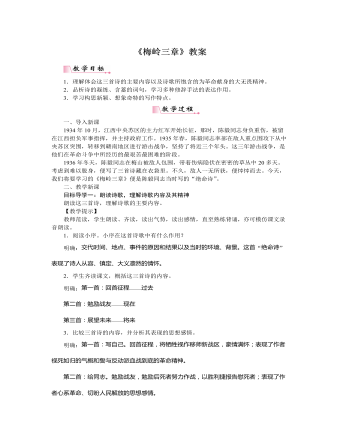
部编版语文九年级下册《梅岭三章》教案
【教学提示】教师范读,学生朗读、齐读,读出气势,读出感情,直至熟练背诵,亦可模仿课文录音朗读。1.阅读小序。小序在这首诗歌中有什么作用?明确:交代时间、地点、事件的原因和结果以及当时的环境、背景。这首“绝命诗”表现了诗人从容、镇定、大义凛然的情怀。2.学生齐读课文,概括这三首诗的内容。明确:第一首:回首征程——过去第二首:勉励战友——现在第三首:展望未来——将来3.比较三首诗的内容,并分析其表现的思想感情。明确:第一首:写自己。回首征程,将牺牲视作移师新战区,豪情满怀;表现了作者视死如归的气概和誓与反动派血战到底的革命精神。第二首:给同志。勉励战友,勉励后死者努力作战,以胜利捷报告慰死者;表现了作者心系革命、切盼人民解放的思想感情。第三首:望未来。展望未来,表现了作者乐观坚定的革命信念和甘为信仰牺牲的革命精神。
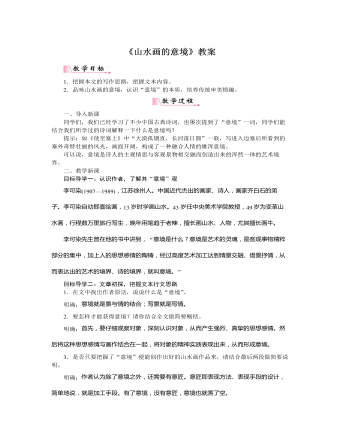
部编版语文九年级下册《山水画的意境》教案
2.作者要说的是山水画的意境,为什么要在第一部分大篇幅分析诗歌的意境。明确:按照作者的观点,“孤帆远影碧空尽,唯见长江天际流”两句,完全描写自然的景色,然而就在这两句里,使人深深体会到诗人与朋友的深厚友情。描写自然的景色与绘出景色无异,且作者提到“意境就是景与情的结合”,可见诗歌中的意境与山水画的意境是相通的,并无二致。因此,作者在这里以已经学习过的诗歌意境为例,也就能更好地诠释山水画的意境。3.“意境的产生,有赖于思想感情,而思想感情的产生,又与对客观事物认识的深度有关。”作者是如何论述此观点的?你认为这个观点正确吗,请结合你的个人经历做简要说明。明确:作者以齐白石画虾为例来论证了他的观点。这个观点正确,如我们知道松树的耐寒可以象征它的坚忍,而当我们在雪地里认真观察,会发现只有松树傲然长青,松针贯穿积雪依然向上,此刻,我们会真正感受到这种坚忍的品质是那样真实。
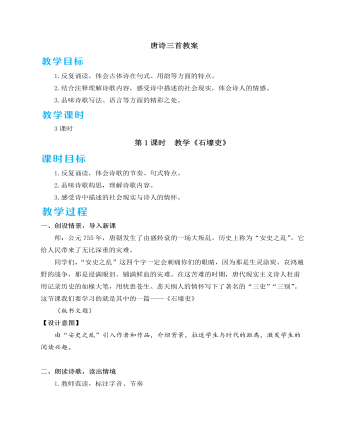
人教部编版语文八年级下册《唐诗三首》教案
(生练读课文)2.读出层次,概括内容师:请同学们自由朗读课文、借助课下注释,用自己的话把卖炭翁的故事讲给同桌听。故事示例:一个卖炭的老翁,一年到头都在终南山里砍柴、烧炭。他满脸灰尘,脸色完全是烟熏火燎的颜色;两鬓的头发已经斑白,十个指头却像炭一样黑。卖了炭得到一点钱,拿来做什么用呢?只不过是为了身上的衣裳和口中的饭食。可怜他身上的衣服破旧又单薄,但他却担心炭价太低,只盼望天气更加寒冷……(生自由朗读,根据课下注释理解内容,讲故事)师:请同学们用“人物+事件”的方式概述卖炭翁的遭遇。(生交流明确,师引导)预设 诗歌主要讲了一个卖炭翁辛苦烧的一车炭最终被宫使用半匹红纱一丈绫掠夺一空的故事。师:这首诗围绕着“炭”叙事,如果主体事件用“失炭”来概括的话,前面还记叙了哪些事?请同学们填空。
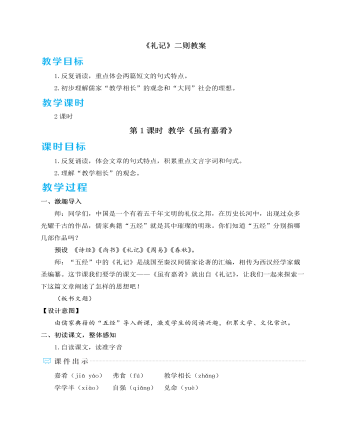
人教部编版语文八年级下册《礼记》二则教案
预设 (1)“大道”可以理解为治理社会的最高准则。“大同”指儒家的理想社会或人类社会的最高阶段。“大道之行也”是指执政者施行“大道”,老百姓便可以生活在安定和平的大同社会。(2)天下为公;选贤与能,讲信修睦。(3)“大同”社会是以“五帝之世”的传闻为依据,经过加工提炼而后构想出来的一个理想社会的模式。意在建立一个合理的社会,以消除现实社会中的黑暗现象和不合理的地方。3.拓展延伸师:你认为这种理想社会在当时实现了吗?如何理解这种思想?(生交流讨论,师引导)预设 “谋闭而不兴,盗窃乱贼而不作”是一种和平安定的局面,是对“大同”社会的一个总结,这个理想在当时并没有实现,因为小生产的物质基础不足以支撑“大同”社会的运转,还有搞阴谋、盗窃财物和作乱等奸邪之事。这种理想在当时虽不能实现,但它具有积极意义,是我们的精神财富。
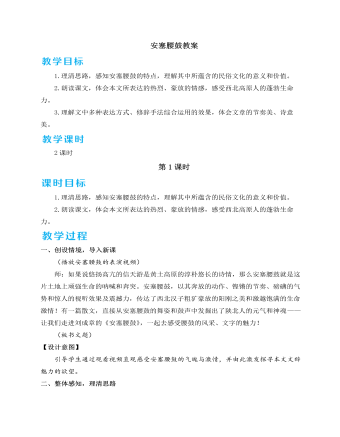
人教部编版语文八年级下册安塞腰鼓教案
2.反复诵读,体验感悟(1)学生选择喜欢的语段自由诵读。(2)小组内互相听读,分享体悟和收获:激荡的生命、磅礴的力量与阳刚之美……结束语:作者笔下,多短句,简洁有力、脆生响亮;多排比,既有句内的排比,又有句子之间、段落之间的排比,还能连段而下,交错互出;即使不单独直接描写腰鼓释放的磅礴能量,也从人的感觉、人的联想和群山、大地等周围环境的回响上,多方位地渲染着它的奇特效应;自始至终采用行进的、动态的描写,使人的动作与腰鼓的声响,在共时态中互激互融,合而为一,从艺术上组成一个表现着生命之源和力量之泉的整体。这一切形式上的追求,在文章中造成了一种快速跃动的节奏、炽热灼人的氛围、排山倒海般的气势,恰与作者所要歌之颂之的人的生命力量相辅相契。这感染力不仅源自安塞腰鼓本身的艺术风采,更是作者综合运用各种修辞、技巧表达出的文字魅力!
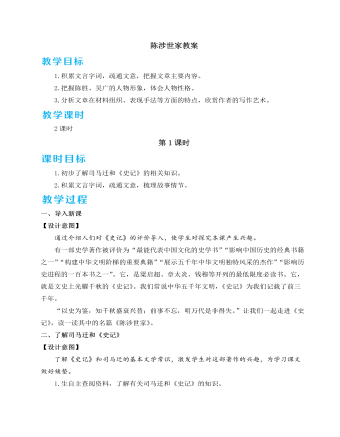
人教部编版语文九年级下册陈涉世家教案
1.王侯是一个地区的实际统治者,世代保有其国,对全国政局有一定的影响,故其传记称为“世家”。陈涉并非王侯,司马迁为什么把他归入“世家”?《史记》中人物传记分为三类,“本纪”记帝王,“世家”记王侯,“列传”记人臣,但这只是一个大略的划分,对于某些历史人物,作者有他特殊的考虑。陈涉就是一个特例。他出身低微,起义后虽自立为王,但为时仅六个月。之所以列入“世家”,是因为在秦王朝的严酷统治下首先发难,的确是非常之功。司马迁在这篇传记的最后写道:“陈胜虽已死,其所置遣侯王将相卒亡秦,由涉首事也。”可见司马迁看重的是功业,而不以成败论英雄。类似的例子有项羽,他并未统一称帝,但作者高度评价了他在反秦斗争中的领导作用,把他列入“本纪”。2.本文是长篇节选,在结构上具有怎样的特点?





